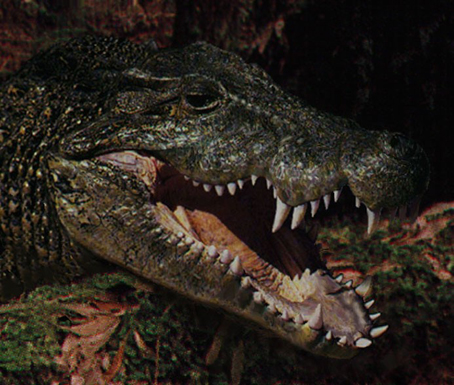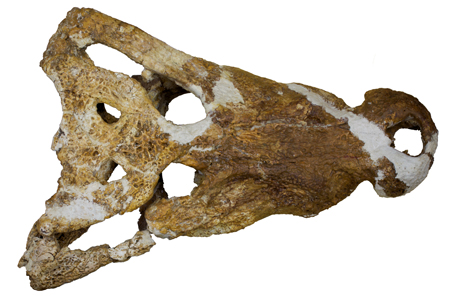Baru – New Information on Australia’s Ancient “Super Croc”
New Specimens of Extinct Crocodylian Baru Described
Australia might be home to some very unusual flora and fauna, but ever since the break-up of the ancient super-continent of Gondwana and the resulting separation of Australia from Antarctica during the Late Cretaceous, this substantial landmass has been isolated. This isolation has enabled the development of unique ecosystems, many of which included super-sized animals much larger than those found in Australia today.
A paper published in the on-line open access journal PeerJ provides new information on one such ancient Australian resident, a genus of broad-snouted crocodile that probably specialised in ambushing large vertebrates, a formidable predator of prehistoric Australia. The scientific paper describes new specimens of an extinct crocodylian genus Baru. One species, Baru wickeni was previously only known from fossil material collected from the famous Riversleigh World Heritage area in Queensland. However, the paper describes new B. wickeni fossil discoveries from a site approximately twenty-five miles south of Alice Springs in the Northern Territory. Thus, the known range for Baru wickeni has been extended.
A Reconstruction of the Large Prehistoric Crocodile Baru wickeni
Picture credit: Paul Willis
In addition, the paper documents the species of another member of the Baru genus – Baru darrowi. B. darrowi was previously only known from the Bullock Creek site in the Northern Territory, but fossils of this reptile have also been found in the Riversleigh World Heritage area. Thus, the range of this species has been extended too.
Baru – A Formidable Ancient Aussie Crocodile
Crocodiles assigned to the Baru genus were formidable, large predators equivalent in length to a fully-grown, extant Saltwater crocodile (Crocodylus porosus). The skull was much more robust, the snout was broader and the head was deeper. Furthermore, the teeth were proportionately bigger and the jaws were powered by particularly massive muscles. Today’s “Salties” are extremely dangerous and they do attack large vertebrates including people when the opportunity arises, but mostly these crocodiles, the largest living reptiles, subsist on prey much smaller than themselves such as fish and turtles.
The skull and jaw adaptations of Baru indicate that this crocodylian was specialised towards subsisting on large vertebrate prey (animals of similar size to itself), ambushing its victims close to water sources. In outward appearance Baru would have resembled a modern crocodile, but the deeper head and alligator-like overbite would have been more pronounced.
The Significance of the Scientific Paper
Author, Adam Yates, (Senior Curator of Earth Sciences at the Museum of Central Australia, part of the Museum and Art Gallery of the Northern Territory), has established that these two species (B. wickeni and B. darrowi) had much wider geographic ranges that in all likelihood encompassed the northern third to half of the continent. These two species, however, did not compete with each other, as they were separated in geological time. Baru wickeni lived earlier, its fossils date from the Late Oligocene Epoch (about 25 million years ago). In contrast, Baru darrowi lived more recently, its remains are associated with Middle Miocene Epoch deposits (approximately 13 million years old).
A Skull of Baru wickeni from the Riversleigh World Heritage Site (Queensland)
Picture credit: Adam Yates
The picture (above) shows a new skull (dorsal view) of B. wickeni excavated from Riversleigh World Heritage area deposits. This skull represents the most complete skull of any Baru species described to date, full details can be found in the scientific paper: PeerJ Paper.
Helping to Map the Timespan of Australia’s Cenozoic Terrestrial Vertebrate Fossil Sites
The Cenozoic vertebrate fossil assemblages of Australia have proved troublesome to date accurately due to the vast distances evolved between sites and their temporal isolation. As these species of crocodiles have broad geographical ranges but relatively constrained chronological timespans, these fossils may be helpful when it comes to determining the age of some vertebrate fossil sites in Australia where there is no radiometrically dateable material and no associated mammal fossils that would normally assist with relative dating.
Another interesting implication from this paper is the presence of Baru wickeni from south of Alice Springs in what was then (and still is now) part of the Lake Eyre drainage system. Previously Baru was known only from coastally draining marginal areas of northern Australia, while rocks of the same age in the Lake Eyre Basin of South Australia produced a distinctly different type of extinct crocodile called Australosuchus. It was therefore suggested that Australosuchus was a denizen of the internally draining rivers of central Australia while Baru lurked in the northern fringes in rivers that drained to the north coast.
The presence of Baru wickeni south of Alice Springs, in what is part of the Lake Eyre Basin, disproves this hypothesis. Instead the pattern may be the result of palaeolatitude, and consequently climate, with Australosuchus potentially being more tolerant of cooler conditions and subsequently occupying the cool south and Baru in the warmer northern part of the continent.
The scientific paper: “The biochronology and palaeobiogeography of Baru (Crocodylia: Mekosuchinae) based on new specimens from the Northern Territory and Queensland, Australia” by Adam Yates, published in PeerJ.
Our thanks to Adam Yates and the Museum and Art Gallery Northern Territory for the compilation of this article.
Visit the award-winning Everything Dinosaur website: Everything Dinosaur.



